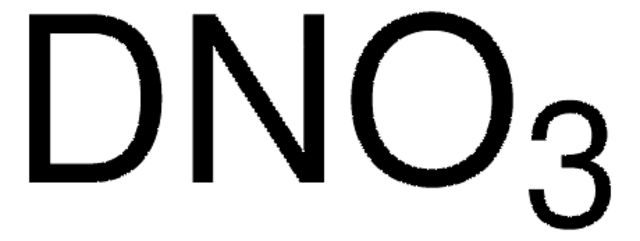1.00443
Nitric acid
65%, EMPLURA®
Synonyme(s) :
Nitric acid solution
About This Item
Produits recommandés
Nom du produit
Acide nitrique solution, EMPLURA®
Pression de vapeur
9.4 hPa ( 20 °C)
Niveau de qualité
Gamme de produits
EMPLURA®
Forme
liquid
Concentration
64.3-66.4% HNO3
Impuretés
≤0.0001% As (Arsenic)
≤0.0003% Chloride (Cl)
≤0.0004% Fe (Iron)
≤0.0005% Heavy metals (as Pb)
≤0.001% Ca (Calcium)
≤0.001% NH4 (Ammonium)
≤0.001% Sulfate (SO4)
≤0.003% Nitrogen oxides (as N2O3)
pH
<1 (20 °C in H2O, strongly acid)
pb
121 °C/1013 hPa
Pf
-32 °C
Densité
1.39 g/cm3 at 20 °C
Température de stockage
2-30°C
Chaîne SMILES
O[N+]([O-])=O
InChI
1S/HNO3/c2-1(3)4/h(H,2,3,4)
Clé InChI
GRYLNZFGIOXLOG-UHFFFAOYSA-N
Vous recherchez des produits similaires ? Visite Guide de comparaison des produits
Application
- In-vitro evaluation of microleakage of bioceramic root-end filling materials: A spectrophotometric study.: This research employed 65% nitric acid for sample preparation in the spectrophotometric analysis of microleakage in dental materials, providing insights into the effectiveness of different bioceramic materials (Gupta and Kewalramani, 2021).
- A comparative evaluation of resin- and varnish-based surface protective agents on glass ionomer cement - a spectrophotometric analysis.: The study used 65% nitric acid for the preparation of glass ionomer cement samples to evaluate the effectiveness of surface protective agents through spectrophotometric methods (Tyagi et al., 2020).
- Spectrophotometric analysis evaluating apical microleakage in retrograde filling using GIC, MTA and biodentine: an in-vitro study.: This research utilized 65% nitric acid in the preparation of samples for the evaluation of microleakage in dental restorative materials, highlighting the performance of various materials in preventing leakage (Nepal et al., 2020).
- Influence of stacked structure of carbons modified on its surface on n-pentane adsorption.: This study applied 65% nitric acid for surface modification of carbon materials, investigating the effects on adsorption properties, with significant findings on how surface structure influences adsorption efficiency (Carvajal-Bernal et al., 2019).
Remarque sur l'analyse
Identity: passes test
Appearance of solution: passes test
Chloride (Cl): ≤ 0.0003 %
Iodate, Bromate: passes test
Nitrogen oxides (as N₂O₃): ≤ 0.003 %
Sulfate (SO₄): ≤ 0.001 %
Heavy metals (as Pb): ≤ 0.0005 %
As (Arsenic): ≤ 0.0001 %
Ca (Calcium): ≤ 0.001 %
Fe (Iron): ≤ 0.0004 %
NH₄ (Ammonium): ≤ 0.001 %
Residual solvents (ICH Q3C): ...excluded by production process
Evaporation residue: ≤ 0.01
Date of expiry: see product label
Informations légales
Mention d'avertissement
Danger
Mentions de danger
Classification des risques
Acute Tox. 3 Inhalation - Eye Dam. 1 - Met. Corr. 1 - Ox. Liq. 3 - Skin Corr. 1A
Risques supp
Code de la classe de stockage
5.1B - Oxidizing hazardous materials
Classe de danger pour l'eau (WGK)
WGK 1
Point d'éclair (°F)
Not applicable
Point d'éclair (°C)
Not applicable
Certificats d'analyse (COA)
Recherchez un Certificats d'analyse (COA) en saisissant le numéro de lot du produit. Les numéros de lot figurent sur l'étiquette du produit après les mots "Lot" ou "Batch".
Déjà en possession de ce produit ?
Retrouvez la documentation relative aux produits que vous avez récemment achetés dans la Bibliothèque de documents.
Les clients ont également consulté
Notre équipe de scientifiques dispose d'une expérience dans tous les secteurs de la recherche, notamment en sciences de la vie, science des matériaux, synthèse chimique, chromatographie, analyse et dans de nombreux autres domaines..
Contacter notre Service technique




